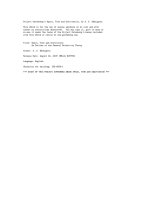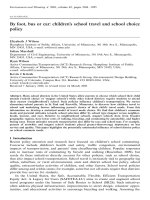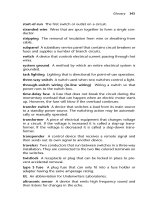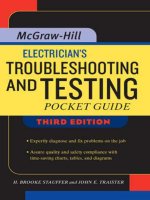electrician's exam question and answers
Bạn đang xem bản rút gọn của tài liệu. Xem và tải ngay bản đầy đủ của tài liệu tại đây (2.39 MB, 314 trang )
TeAM
YYePG
Digitally signed by TeAM YYePG
DN: cn=TeAM YYePG, c=US,
o=TeAM YYePG, ou=TeAM
YYePG, email=
Reason: I attest to the accuracy
and integrity of this document
Date: 2005.04.18 11:51:57 +08'00'
Audel
™
Questions and Answers
for Electrician’s
Examinations
Audel
™
Questions and Answers
for Electrician’s
Examinations
All New Fourteenth Edition
Paul Rosenberg
Vice President and Executive Development Editor: Regina Brooks
Publisher: Robert Ipsen Editorial Manager: Kathryn A. Malm
Vice President and Publisher: Production Editor: Vincent Kunkemueller
Joseph B. Wikert Text Design & Composition: TechBooks
Acquisitions Editor: Katie Feltman
Copyright © 2004 by Wiley Publishing, Inc., Indianapolis, Indiana. All rights reserved.
Published simultaneously in Canada
No part of this publication may be reproduced, stored in a retrieval system, or transmit-
ted in any form or by any means, electronic, mechanical, photocopying, recording, scan-
ning, or otherwise, except as permitted under Section 107 or 108 of the 1976 United
States Copyright Act, without either the prior written permission of the Publisher, or
authorization through payment of the appropriate per-copy fee to the Copyright
Clearance Center, Inc., 222 Rosewood Drive, Danvers, MA 01923, (978) 750-8400,
fax (978) 646-8600. Requests to the Publisher for permission should be addressed to
the Legal Department, Wiley Publishing, Inc., 10475 Crosspoint Blvd., Indianapolis,
IN 46256, (317) 572-3447, fax (317) 572-4447, E-mail:
Limit of Liability/Disclaimer of Warranty: While the publisher and author have used
their best efforts in preparing this book, they make no representations or warranties
with respect to the accuracy or completeness of the contents of this book and specifi-
cally disclaim any implied warranties of merchantability or fitness for a particular pur-
pose. No warranty may be created or extended by sales representatives or written sales
materials. The advice and strategies contained herein may not be suitable for your sit-
uation. You should consult with a professional where appropriate. Neither the pub-
lisher nor author shall be liable for any loss of profit or any other commercial damages,
including but not limited to special, incidental, consequential, or other damages.
For general information on our other products and services please contact our
Customer Care Department within the United States at (800) 762-2974, outside the
United States at (317) 572-3993 or fax (317) 572-4002.
Trademarks: Wiley, the Wiley Publishing logo, and Audel are trademarks or regis-
tered trademarks of John Wiley & Sons, Inc. and/or its affiliates. All other trade-
marks are the property of their respective owners. Wiley Publishing, Inc., is not
associated with any product or vendor mentioned in this book.
Wiley also publishes its books in a variety of electronic formats. Some content that
appears in print may not be available in electronic books.
Library of Congress Cataloging-in-Publication Data
Rosenberg, Paul.
Audel questions and answers for electrician’s examinations / Paul
Rosenberg.— All new 14th ed.
p. cm.
Rev. ed. of: Questions and answers for electricians examinations. 13th ed. 1999,
revised by Paul Rosenberg.
ISBN: 0-7645-4201-X (PAPER/WEBSITE)
1. Electric engineering—Examinations, questions, etc. 2. Electricians—Licenses—
United States. 3. National Fire Protection Association. National Electrical Code
(2002) I. Questions and answers for electricians examinations. II. Title.
TK169.R67 2003
621.319Ј24Ј076—dc22
2003017921
Printed in the United States of America
10 9 8 7 6 5 4 3 2 1
v
Contents
Introduction 1
Tips on Taking Tests 1
Business Competency Examinations 4
Electrical Symbols 10
List of Symbols 12
Signaling System Outlets 16
Signaling System Outlets 21
Chapter 1 Review Definitions 51
Chapter 2 Ohm’s Law and Other Electrical Formulas 59
Series Circuits 60
Parallel Circuits 61
Units of Area and Resistance 64
Skin Effect 70
Voltage-Drop Calculations 71
Formulas for Determining Alternating
Current in Alternating-Current Circuits 73
Formulas for Combining Resistance
and Reactance 74
Relative Conductivity 88
Chapter 3 Power and Power Factor 91
Chapter 4 Lighting 105
Chapter 5 Branch Circuits and Feeders 113
Chapter 6 Transformer Principles and Connections 129
Chapter 7 Wiring Design and Protection 149
Chapter 8 Wiring Methods and Materials 167
vi Contents
Chapter 9 Batteries and Rectification 185
Chapter 10 Voltage Generation 189
Chapter 11 Equipment for General Use 195
Chapter 12 Motors 213
Chapter 13 Motor Controls 231
Common Symbols for Motor Controls 231
Chapter 14 Special Occupancies and Hazardous
(Classified) Locations 253
Chapter 15 Grounding and Ground Testing 267
Answers to Questions 15-46 to 15-74 279
Chapter 16 Data & Communications Wiring 283
Index 293
Introduction
Tips on Taking Tests
It is the author’s experience that, for most electricians, knowing how
to take a test is almost as important as knowing the technical infor-
mation, as far as obtaining a passing grade is concerned. A great
number of electricians fear tests more than they fear 480 volts.
Really, there is no good reason why this should be so. After all, if
hundreds of thousands of men and women can pass these tests,
anyone interested who gives a real effort and pays particular atten-
tion to some basic rules can succeed. Some basic rules for taking
tests are these:
1. Know the material being covered.
2. Know the format of the test.
3. Be physically and mentally prepared on the exam day.
4. RELAX!
5. Work the test the smartest way you can.
The first point—knowing the material being covered—is a
mandatory prerequisite. Most test failures come from violating
this rule. No, it isn’t always easy to learn all the material on a test.
It requires hours, sometimes many hours, of studying when you’d
rather be doing other things. It means that you have to make your
brain work harder than it wants to, going over the material again
and again. Sorry, but unless you have an exceptional aptitude for
learning, there are no shortcuts for hard, intense study. A good
study guide (like this book) is about as much help as you can get.
The second rule for taking tests is that you need to know the for-
mat of the test. Some of the things you need to know are:
How many questions are on the test?
How many questions are open-book?
How many are closed-book?
Do all questions count for the same number of points?
Is there a penalty for wrong answers?
How much time is allowed for each section of the test?
Who wrote the test?
How will the test be graded?
1
2 Introduction
By knowing the answers to these questions, you can plan your
efforts intelligently. For example, if certain questions will count for
more points than others, you should be ready to spend more time
and effort on those questions. By knowing the time limits, you can
calculate how much time you have for each question, etc. Get
answers to all of these questions and consider all of these facts as
you prepare for the exam.
Now, as for being physically and mentally prepared, I think most
readers are familiar with the way athletes prepare for an event.
They make sure they eat the right kinds of food so that they have
enough energy. They get plenty of sleep, and they come to the event
planning on winning. The same thing should be done in prepara-
tion for a test.
The most important factor is what was mentioned above—
planning on winning. Psychologists have found that the results one
achieves are directly related to what one expects to receive. If you
believe that you will do well, you are quite likely to do well; if you
believe that you will do poorly, you probably will. Remember, it
does not matter what you wish for; what matters is what you actu-
ally expect to happen. I’ll pass on to you one of my favorite quotes
along these lines. It comes from Robert J. Ringer: “The results you
produce in life are inversely proportional to the degree to which
you are intimidated.”
If you want to improve your confidence (expectations) in your
test-taking abilities, picture yourself as having aced the test. Refuse
to imagine yourself failing, and spend as much time studying as is
necessary for you to believe in yourself.
On the day of a test, you want to walk in well rested (but not
still groggy), having been well fed (but not full), and with a subdued
confidence. Generally, heavy studying the night before the test is
not a good idea. Do a light review and leisurely go over a difficult
part of the information if you like, but the night before is not the
time to get intense. You should have been intense two weeks ago.
The night before the test is a time to eat well and to go to bed early.
Try not to eat within two or three hours of the test, as it tends to
bog you down. It has been said that mental efficiency is highest on
an empty stomach.
Confidence is built on a good knowledge of the material to be
covered and the ability to pass with style.
Upon entering the test location, relaxing is very important. If you
choke up during the test, you are automatically taking five points off
your score, possibly more. You should have the same attitude as the
runner who shows up for a race he knows he will win. He is ready
to run his fastest, but he is not nervous because he knows that his
fastest is good enough.
Before taking the test, clear your mind, don’t get involved with
trivial conversations, and then, when it is time to answer the ques-
tions, dig into the test with your full strength.
During the test, first answer all of the easy questions; pass up the
hard questions for now, and do only the ones you know for sure.
Then, once you have answered these questions, don’t go over them
again; just move on to the next group of questions. Next, do the
questions that will require some work, but don’t do the most diffi-
cult questions; save them for last. It is silly to waste half of your
time on one difficult question. Do the 47 easier questions, and then
come back to the three especially difficult ones.
Work the test in the smartest possible way. Pay attention to time
requirements, books allowed during open-book tests, etc. For your
electrical exam, you should definitely put tabs on your Code book.
Bring an electronic calculator with you and some scratch paper (as
long as you are allowed to). Rather than buying a set of Code book
tabs, I recommend that you do your own. Tab the index and the
sections of the Code that you most commonly use. I generally put
tabs on the following:
Tables 250.66 & 250.122 (Sizes of ground wires)
Table 310.16 (Wire ampacities)
Appendix C (Conduit fill tables)
Article 230 (Services)
Table 300.5 (Burial depths)
Table 370.6 (Number of wires in boxes)
Article 430 (Motors)
Article 450 (Transformers)
Article 490 (Over 600 volts)
Article 500 (Hazardous location wiring)
Article 700 (Emergency systems)
Remember
If hundreds of thousands of other people have passed these tests, you
can too—if you prepare.
Introduction 3
4 Introduction
Business Competency Examinations
In recent years, many municipalities have added business compe-
tency examinations to their standard Master Electrician examina-
tions. In reality, they didn’t have much choice. Since 1980, the
number of licensed electrical contractors has skyrocketed, causing a
great number of problems. Most of these problems were the result
not of a lack of technical knowledge but of bad business practices.
After some study, the various State Departments of Professional
Regulation found out that while the newly licensed electrical con-
tractors were proficient at trade skills they were woefully inade-
quate in business skills.
In an effort to ensure that newly licensed contractors are knowl-
edgeable in business, new sections have been added to many com-
petency examinations. Typically, 25 percent of a Master Electrician
exam is dedicated to business skills and knowledge. The following
are the topics usually covered:
1. Taxes
2. Unemployment and worker’s compensation
3. OSHA and safety
4. Lien laws
5. Business skills
To help familiarize you with the various requirements and refer-
ence sources, each of these topics will be briefly discussed and then
followed with questions and answers.
The Taxes section of such tests covers withholding of employee
taxes. The information needed to answer these questions can be
found in various IRS publications. (The easiest way to obtain
these publications is to download them from the IRS’s web site—
Knowing the pro-
per rules for withholding federal income tax, social security, federal
unemployment, and state taxes is critical, not only for your test but
also in order to operate a business. Let me state this clearly: The
IRS is neither understanding nor compassionate, and it won’t cut
you even a little bit of slack for an ignorant infraction of its rules.
The business of the IRS is to collect as much of your money as it is
entitled to. Learn the rules for the test, and if and when you open a
business, engage the services of a good accountant.
Unemployment compensation is paid directly to the state by the
employer. It is not deducted from the employee’s wages. Rates vary,
and there are a number of requirements for anyone receiving this
compensation. All of the required information can be found in a
booklet called “Unemployment Compensation Handbook,” which
is available through various sources, including your public library.
Worker’s compensation is handled on the state level, and the
requirements vary from state to state; because of this, you will have to
get local requirements from your state government. The people
who administer your local test should be able to guide you to the
right place.
OSHA (Occupational Safety and Health Administration) estab-
lishes rules to ensure that no employee is subjected to dangers to his
or her safety or health. The OSHA regulations can be found in
“OSHA Standard 2207, Part 1926.” There are too many regula-
tions to memorize, but one must be familiar enough with the book
to be able to find the answer to any question easily.
Each state has its own lien laws. Copies of the regulations must be
obtained through your own state government, although the testing
agency administering your test can probably tell you exactly how to
get them. Liens are very important in the construction business and
have been developed primarily for the benefit of the contractor.
The business skills part of the test deals mostly with banks,
financing, and basic management skills. As a reference source
for the exam, “Tax Guide for Small Business” is recommended.
This book, published by the IRS Division of the Treasury
Department, is available from your local office of the Small
Business Administration (SBA). There are many, many other busi-
ness books available (and I would hope that anyone going into
business would read several), but this handbook addresses the
material in the test more directly.
You should remember, however, that the business skills covered
by these tests are not enough to ensure success in business. In addi-
tion to these skills, you will need skill in dealing with people, the
ability to analyze a market, and the ability to make and follow
through on decisions. This test covers only academic business skills;
to actually make money, you will need other skills also.
I-1 If a certain employee spends less than half of his time during
a pay period performing services that are subject to taxation, how
much of his or her pay is taxable?
All employees are taxable.
I-2 If an employer fails to make federal income tax deposits when
they are due, how large a penalty will they be assessed?
10 percent.
Introduction 5
6 Introduction
I-3 A self-employed person is considered an employee. True or
false?
False.
I-4 What form must be used to correct errors in withholding
taxes?
941C.
I-5 What would be the take-home pay of a worker who claims
one deduction, is married, and who earns $500.00 per week (with-
out state or local taxes)?
I-6 For unemployment taxation, the term “employer” includes
any person or organization that paid _________ or more in wages
in any quarter or had employees at any time in 20 weeks of the
year.
$1,500.00.
I-7 If an employee is paid $325.00 per week, how much Social
Security and Medicare tax should be deducted from his or her wages?
325.00 ϫ 7.65% ϭ $24.86.
I-8 What form is used to get an Employer Identification Number?
SS-4.
I-9 What form must a new employee sign before beginning work?
W-4.
I-10 If an employer has _____ or more employees in 20 or more
weeks, the employer must file a Form 940 Federal Unemployment
Act.
1.
I-11 On what portion of his or her wages must an employee con-
tribute for state unemployment compensation?
The first $9,000.00 of wages.
500.00
156.002 Federal
Income Tax Withholding
131.002 Social
Security
(7.252
$405.75
Medicare
Introduction 7
I-12 Casual labor is labor that is occasional, incidental, and not
exceeding ___ working days in duration.
10.
I-13 Does a temporary light fixture with a reflector that deeply
recesses its bulb require a guard?
No.
I-14 How long may double cleat ladders be?
15 feet.
I-15 What is the angle of repose for average soil?
45 degrees.
I-16 How many gallons of flammable liquid can be stored in a
room outside of an approved storage cabinet?
25.
I-17 When an interior-hung scaffold is suspended from the beams
of a ceiling, what percentage of the rated load must the suspending
wire be capable of supporting?
600 percent (six times the rated load).
I-18 What is the proper maintenance procedure for an “ABC”
dry-chemical stored-pressure fire extinguisher?
Check the pressure gauge and the condition of the chemical
annually.
I-19 Workers should not be exposed to impulsive or impact noises
louder than _____ decibels.
140.
I-20 What is the standard height for a guardrail?
42 inches.
I-21 What is the minimum size (OSHA requirement) of a conduc-
tor to a ground rod?
#2 AWG copper.
I-22 For a scaffold with a working load of 75 pounds per square
feet, what is the maximum span for a 2؆؋12؆ plank?
7 feet.
I-23 Loaded powder-activated tools may not be left _______.
Unattended.
8 Introduction
I-24 What should be the predominant color of caution signs?
Yellow.
I-25 For 225 employees on a construction site, how many toilets
must be provided?
Five toilet seats and five urinals.
I-26 When safety belts are used, the maximum distance of fall
must be ______.
6 feet.
I-27 What is the minimum lighting level in a field construction
office?
30 foot-candles.
I-28 Manually handled lumber cannot be stacked higher than
______.
16 feet.
I-29 What is the term for the claims of a creditor against the assets
of a business?
Liabilities.
I-30 Small Business Administration loans can be guaranteed up to
______.
90 percent.
I-31 Would taxes be considered a liability?
Yes.
I-32 The assets of a business, minus its liabilities, are called its
_______.
Equity.
I-33 Accounts receivable financing is normally based on receiv-
ables that are how old?
70 to 90 days.
I-34 If your company has gross sales of $210,000.00 and expenses
of $198,500.00, what percentage of profit did it make?
5.5 percent.
I-35 An agreement by which you get exclusive use of a certain item
for a stated period of time is called a ______.
Lease.
I-36 What is the minimum rate of return sought by most venture
capitalists?
It is currently around 10 percent (or higher), but this figure
can be modified by changes in interest rates, inflation, etc.
I-37 A one-year line of credit refers to a note that is renewable for
one year at ___-day intervals.
90.
I-38 What is the term for a plan of cash receipts and expenditures
for a certain period of time?
A cash budget.
I-39 What is the term for the money required to carry accounts
receivable, cover payrolls, and buy products?
Working capital.
I-40 Is an 18-year-old boy, employed by his parents, exempt from
Social Security tax?
Yes.
I-41 Is a wife, employed by her husband, subject to Social Security
tax?
No.
I-42 What are the two primary account methods?
Cash accounting and accrual.
I-43 Are all types of business activities voluntary?
No, the payment of taxes is enforced. Almost every other
type of business activity is voluntary between the parties
involved.
I-44 What type of law covers the awarding of damages for acci-
dental injuries and the like?
Torts.
I-45 Define “overhead.”
“Overhead” is the money necessary to keep a company operat-
ing, even if there is no one working in the field. It includes every-
thing except material, labor, and job expenses. Office expenses,
office salaries, sales expenses, office equipment, vehicles, and
similar expenses are considered to be overhead.
Introduction 9
10 Introduction
I-46 What does the term “Net 30” indicate?
“Net 30” indicates a payment procedure. In general, it means
that if one party to a transaction presents a valid invoice, it will
be paid by the other party within 30 days.
I-47 What is “cash flow,” and why is it important?
“Cash flow” is a general term describing the flow of cash
within a company. It is important because electrical construction
work is almost always done on credit, sometimes leaving the
contractor in a situation in which he or she is making a lot of
money but hasn’t collected it yet and therefore has no cash with
which to pay bills. Insufficient cash has been the ruin of many
construction firms.
I-48 What are the functions of profit in a company?
There are two. The first is to offset risks. Without some extra
money in a contract, even a small difficulty would cause the pro-
ject to go over budget. The second is to give the owners of the
company a return on their investment. If the owners did not get
a return on their money, they would have no reason to put it to
use in the company.
I-49 What are job expenses?
Expenses—such as storage trailer rental, tool rentals, and job
telephones—that are caused by the project and not by continu-
ing operations.
I-50 How does OSHA make sure that their rules are followed?
By imposing fines on companies that are judged to be in
violation.
Electrical Symbols
To avoid confusion, ASA policy requires that the same symbol not be
included in more than one Standard. If the same symbol were used in
two or more Standards and one of these Standards were revised,
changing the meaning of the symbol, considerable confusion could
arise over which symbol was correct, the revised or unrevised.
The symbols in this category include, but are not limited to, those
listed below. The reference numbers are the American Standard
Y32.2 item numbers.
Introduction 11
46.3 Electric motor
46.2 Electric generator
86.1 Power transformer
82.1 Pothead (cable termination)
48 Electric watthour meter
12.2 Circuit element, e.g.,
circuit breaker
11.1 Circuit breaker
36 Fusible element
76.3 Single-throw knife switch
76.2 Double-throw knife switch
13.1 Ground
7 Battery
MOT
GEN
WH
CB
ϩϪ
Electrical Symbols.
12 Introduction
List of Symbols
1.0 Lighting Outlets
1.1 Surface or pendant
incandescent, mercury
vapor, or similar lamp
fixture
1.2 Recessed incandescent,
mercury vapor, or
similar lamp fixture
1.3 Surface or pendant
individual fluorescent
fixture
1.4 Recessed individual
fluorescent fixture
1.5 Surface or pendant
continuous-row
fluorescent fixture
1.6 Recessed continuous-
row fluorescent fixture*
1.7 Bare-lamp fluorescent
strip**
1.8 Surface or pendant exit
light
1.9 Recessed exit light
(continued)
Ceiling Wall
*In the case of combination continuous-row fluorescent and incandescent spotlights,
use combinations of the above Standard symbols.
**In the case of a continuous-row bare-lamp fluorescent strip above an area-wide
diffusion means, show each fixture run, using the Standard symbol; indicate area of
diffusing means and type of light shading and/or drawing notation.
RR
0
0R
0
0R
XX
XR XR
2.0 Receptacle Outlets
Unless noted to the contrary, it should be assumed that every recep-
tacle will be grounded and will have a separate grounding contact.
Use the uppercase subscript letters described under Section 2
item a-2 of this Standard when weatherproof, explosion-proof, or
some other specific type of device will be required.
Introduction 13
Lighting Outlets.
1.10 Blanked outlet
1.11 Junction box
1.12 Outlet controlled by
low-voltage switching
when relay is installed
in outlet box
L L
B B
J J
2.1 Single receptacle outlet
2.2 Duplex receptacle outlet
2.3 Triplex receptacle outlet
2.4 Quadruplex receptacle
outlet
2.5 Duplex receptacle
outlet—split wired
2.6 Triplex receptacle
outlet—split wired
2.7 Single special-purpose
receptacle outlet*
(continued)
*Use numeral or letter, either within the symbol or as a subscript alongside the sym-
bol keyed to explanation in the drawing list of symbols, to indicate type of receptacle
or usage.
14 Introduction
2.8 Duplex special-purpose
receptacle outlet*
2.9 Range outlet
2.10 Special-purpose
connection or provision
for connection. Use
subscript letters to
indicate function (DW—
dishwasher; CD—clothes
dryer, etc.)
2.11 Multioutlet assembly.
Extend arrows to limit of
installation. Use
appropriate symbol to
indicate type of outlet.
Also indicate spacing of
outlets as x inches.
X
"
*Use numeral or letter, either within the symbol or as a subscript alongside the sym-
bol keyed to explanation in the drawing list of symbols, to indicate type of receptacle
or usage.
R
DW
2.12 Clock Hanger Receptacle
2.13 Fan Hanger Receptacle
2.14 Floor Single Receptacle
Outlet
2.15 Floor Duplex Receptacle
Outlet
2.16 Floor Special-Purpose
Outlet*
(continued)
*
C
F
Introduction 15
2.17 Floor Telephone
Outlet—Public
2.18 Floor Telephone
Outlet—Private
Not a part of the Standard:
example of the use of several
floor outlet symbols to identify
a 2-, 3-, or more-gang floor
outlet
2.19 Underfloor Duct and
Junction Box for Triple,
Double or Single Duct
System as indicated by
the number of parallel
lines
J
Not a part of the Standard:
example of use of various
symbols to identify location of
different types of outlets or
connections for underfloor duct
or cellular floor systems
2.20 Cellular Floor Header
Duct
Receptacle Outlets.
16 Introduction
3.0 Switch Outlets
3.1 Single-pole switch
3.2 Double-pole switch
3.3 Three-way switch
3.4 Four-way switch
3.5 Key-operated switch
3.6 Switch and pilot lamp
3.7 Switch for low-voltage switching system
3.8 Master switch for low-voltage switching
system
3.9 Switch and single receptacle
3.10 Switch and double receptacle
3.11 Door switch
3.12 Time switch
3.13 Circuit-breaker switch
3.14 Momentary contact switch or pushbutton
for other than signaling system
S
S
2
S
3
S
4
S
K
S
P
S
L
S
LM
S
S
S
D
S
T
S
CB
S
MC
Switch Outlets.
Signaling System Outlets
4.0 Institutional, Commercial, and Industrial Occupancies
These symbols are recommended by the American Standards
Association but are not used universally. The reader should remem-
ber not to assume that these symbols will be used on any certain
plan and should always check the symbol list on the plans to verify
whether these symbols are actually used.
Introduction 17
Basic Examples of
Symbol Individual Item
Identification
(Not a part of
the Standard)
1
2
3
4
5
6
1
2
3
4.1 I. Nurse Call System Devices
(and type)
4.2 II. Paging System Devices
(any type)
Nurses’ Annunciator (can add a
number after it as 24 to
indicate number of lamps)
Call station, single cord, pilot
light
Call station, double cord,
microphone speaker
Corridor dome light, 1 lamp
Transformer
Any other item on same system—
use numbers as required.
1
Keyboard
Flush annunciator
2-face annunciator
(continued)
Any other item on same system—
use numbers as required.
4









